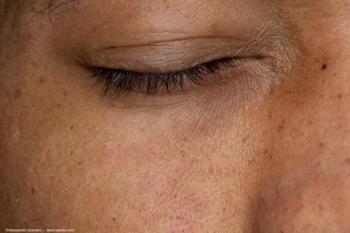
Role of mucormycosis infection on vision in diabetic patient
Key Takeaways
- Mucormycosis is a life-threatening fungal infection, often affecting diabetic or immunocompromised individuals, leading to vascular thrombosis and tissue necrosis.
- Rhino-orbital-cerebral mucormycosis (ROCM) can present with sudden vision loss and cranial nerve palsies, requiring rapid diagnosis and management.
A recent report published by Turkish investigators showed that mucormycosis infection should not be overlooked in the differential diagnosis in patients with diabetes who present with sudden vision loss and cranial nerve palsies,¹ according to Irem Sena Sarac, MD, first author and ophthalmology resident in the Department of Ophthalmology, Prof. Dr. Cemil Tascioglu Sehir Hastanesi City Hospital, Istanbul.
Sarac and colleagues explained that rhino-orbital-cerebral mucormycosis (ROCM) is a severe, life-threatening fungal infection caused by opportunistic fungi of the order Mucorales, most often Rhizopus oryzae.2 This infection typically occurs in patients with diabetes mellitus or those who are immunocompromised.
The spores of the fungus can be inhaled or enter the body through sites of burns or trauma.2,3 Uncontrolled diabetes mellitus, hematologic malignancies, and immunosuppressive therapy are the major risk factors for ROCM infection.3,4 Once established in the body, the results are often vascular thrombosis and tissue necrosis.4 The most common clinical presentations of mucormycosis are ROCM and pulmonary mucormycosis.5
ROCM case
A 64-year-old woman with diabetes arrived at the emergency department reporting dizziness, headache, and decreased vision in the left eye that had persisted over the course of 1 week.
On initial examination in the ophthalmology department, the best-corrected visual acuities in the right and left eyes, respectively, were 6/60 and no light perception.
While the anterior chamber of the right eye was normal, funduscopy showed retinal hemorrhages and exudates consistent with diabetic retinopathy, and the optic disc appeared normal.
The pupil in the left eye was nonreactive to light. Ptosis, mild proptosis, and chemosis in the left eye were observed, with no eyelid edema or hyperemia. The extraocular motility of that eye was limited in all directions. The anterior segment was normal. Fundus examination showed optic disc edema, retinal hemorrhages, and exudates consistent with diabetic retinopathy, and retinal pallor with a cherry-red spot at the fovea consistent with central retinal artery occlusion. On day 2 of hospitalization, eyelid edema and hyperemia developed in the left eye.
Laboratory testing showed leukocytosis with neutrophil predominance, elevated C-reactive protein, hyperglycemia, and elevated hemoglobin A1c. Non-contrast orbital and paranasal sinus computed tomography scans showed left orbital cellulitis, proptosis, and severe ethmoidal and maxillary sinusitis.
R. oryzae was identified by histopathologic examination. No black necrotic tissue was apparent in the nasal and sinus mucosa and skin. Blood cultures showed no growth. Cranial magnetic resonance imaging showed maxillary and ethmoidal sinusitis and increased T2 signal intensity surrounding the left optic nerve, consistent with inflammation, the investigators described.
Management included antifungal treatment, i.e., increasing dosages of liposomal amphotericin B; left orbital exenteration; and endoscopic sinus surgery. One week after exenteration, the C-reactive protein value decreased, and a week later, imaging showed progressed sinusitis followed by another sinus surgery, after which the disease stabilized.
The next round of blood cultures grew pan-resistant Klebsiella and Pseudomonas aeruginosa, and acute renal failure ensued.
During follow-up, no signs of infection or inflammation were observed in the right eye or orbit. Despite intensive treatment and surgery, the patient died on day 64 of the hospitalization.
Sarac and colleagues commented, “Mucormycosis is an angiotropic fungal infection that invades the internal elastic lamina of blood vessels, leading to angioinvasion, hemorrhagic necrosis, and vascular thrombosis, particularly affecting arteries, veins, and lymphatics, through both mechanical compression and toxin-mediated damage.6 Vision loss may be due to central retinal artery occlusion or orbital apex involvement affecting the optic nerve function.6 In our case, central retinal artery occlusion was suspected to have occurred either due to compression of the ophthalmic artery from soft tissue invasion of the orbital apex or as a direct result of angioinvasion by the fungus.”
Considering this patient’s course, the investigators concluded, “Mucormycosis infection should be considered as a differential diagnosis in diabetic patients presenting with sudden vision loss and cranial nerve palsies. Mucormycosis is a rapidly progressing, devastating infection that requires rapid diagnosis and management by a multidisciplinary team.”
References
Sarac I, Aksu Y, Yildiz D, et al. Rhino-orbital mucormycosis presenting with central retinal artery occlusion: a case report. Cureus.2025;17:e88020. doi:10.7759/cureus.88020.
Katsitadze L, Javakhishvili G, Burkadze G, et al.
Mucormycosis in a diabetic patient: a case report from Georgia . Cureus. 2024;16:e69399.10.7759/cureus.69399 Bitar D, Van Cauteren D, Lanternier F, et al.
Increasing incidence of zygomycosis (mucormycosis), France, 1997-2006 . Emerg Infect Dis.2009;15:1395-401.10.3201/eid1509.090334 Ribes JA, Vanover-Sams CL, Baker DJ.
Zygomycetes in human disease . Clin Microbiol Rev. 2000;13:236-301.10.1128/CMR.13.2.236 Benlamkaddem S, Zdaik G, Doughmi D, et al.
Rhino-orbital cerebral mucormycosis: a fatal evolution . Cureus. 2023;15:e37837.10.7759/cureus.37837 Sethi NK, Chadha C, Bajaj M, Moond H. Central retinal vein occlusion as primary ocular manifestation of rhino-orbital-cerebral mucormycosis: A case report. Indian JOphthalmol. 2022;704451-3. DOI:10.4103/ijo.IJO_1318_22
Newsletter
Don’t miss out—get Ophthalmology Times updates on the latest clinical advancements and expert interviews, straight to your inbox.


















































.png)


